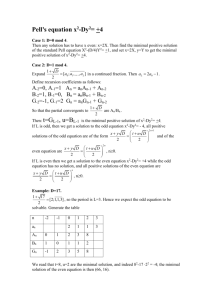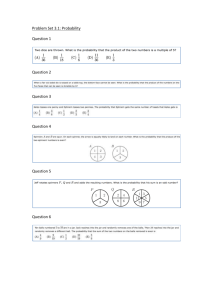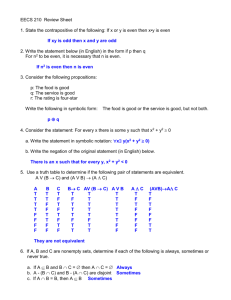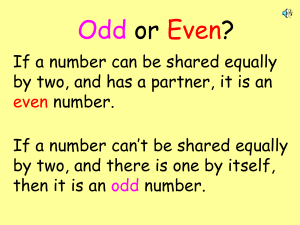P(B|A) = P( A and B)
advertisement
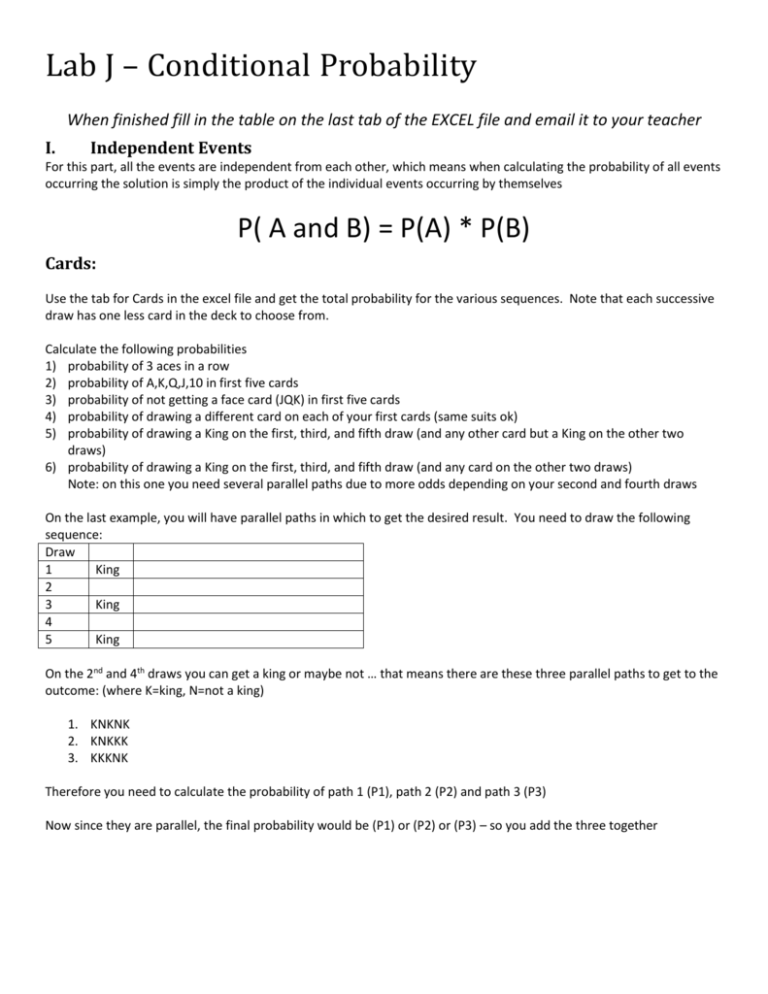
Lab J – Conditional Probability When finished fill in the table on the last tab of the EXCEL file and email it to your teacher I. Independent Events For this part, all the events are independent from each other, which means when calculating the probability of all events occurring the solution is simply the product of the individual events occurring by themselves P( A and B) = P(A) * P(B) Cards: Use the tab for Cards in the excel file and get the total probability for the various sequences. Note that each successive draw has one less card in the deck to choose from. Calculate the following probabilities 1) probability of 3 aces in a row 2) probability of A,K,Q,J,10 in first five cards 3) probability of not getting a face card (JQK) in first five cards 4) probability of drawing a different card on each of your first cards (same suits ok) 5) probability of drawing a King on the first, third, and fifth draw (and any other card but a King on the other two draws) 6) probability of drawing a King on the first, third, and fifth draw (and any card on the other two draws) Note: on this one you need several parallel paths due to more odds depending on your second and fourth draws On the last example, you will have parallel paths in which to get the desired result. You need to draw the following sequence: Draw 1 King 2 3 King 4 5 King On the 2nd and 4th draws you can get a king or maybe not … that means there are these three parallel paths to get to the outcome: (where K=king, N=not a king) 1. KNKNK 2. KNKKK 3. KKKNK Therefore you need to calculate the probability of path 1 (P1), path 2 (P2) and path 3 (P3) Now since they are parallel, the final probability would be (P1) or (P2) or (P3) – so you add the three together Dice: Use the tab for Dice in the excel file and get the probabilities for all the outcomes when tossing successive dice The first part is a regular six sided die with a 1,2,3,4,5,and 6 face 1) 2) 3) 4) first Odd 1 >1 <6 second Even 2 >2 <5 third Odd 3 >3 <4 fourth fifth sixth 4 >4 <3 5 >5 <2 6 fourth fifth sixth Odd 4 >4 <3 Even 5 >5 <2 Even 6 The second part is a seven sided die with a 1,2,3,4,5,6 and 7 face 1) 2) 3) 4) 5) 6) first Odd Even Odd 1 >1 <6 Second Even Odd Even 2 >2 <5 third Odd Even Even 3 >3 <4 Extra credit problem: A box contains 6 white balls and 4 red balls. We randomly (and without replacement) draw two balls from the box. What is the probability that the second ball selected is red? II. Dependent Events For this part, two events have a probability that is dependent on each other, which means when calculating the probability of all events occurring the solution can be written as P( A and B) = P(A) * P(B|A) Where P(B|A) means the probability of B given that A has already occurred A good example of this is a class that has take two tests A and B. If 30% passed the first test and 60% passed the second, your intuition would say that the students that passed the first test are more that 60% likely to pass the second. So let’s say we know that 25% passed both test. Now you can find the conditional probability using the formulae above, and solving for the new term P(B|A) = P( A and B) /P(A) * So for this example: P(B|A) = 0.25 / .3 = .83 = 83% So if you passed the first test you have an 83% chance of passing the second. Here are a few to solve: 1) In the United States, 55% of children get an allowance and 41% of children get an allowance and do household chores. What is the probability that a child does household chores given that the child gets an allowance? 2) At a large high school, the probability that a student takes Japanese and Spanish is 0.08. The probability that a student takes Spanish is 0.45. What is the probability that a student taking Japanese given that the student is taking Spanish? 3) A new superman MasterCard has been issued to 2000 customers. Of these customers, 1500 hold a Visa card, 500 hold an American Express card and 40 hold a Visa card and an American Express card. Find the probability that a customer chosen at random holds a Visa card, given that the customer holds an American Express card. These next two are challenging and need the addition of making a probability tree (ec) 4) 937 men died in my town last year. 212 died of heart disease. 312 had at least one parent who had heart disease. Of the 312 men with at least one parent with heart disease, 102 died of causes related to heart disease. Using this information, if we randomly select a man from the region, what is the probability that he dies of causes related to heart disease given that neither of his parents died from heart disease? 5) A weather station in a certain area gathers data about the chance of precipitation. It predicts that, if it rains on a given day, 50% of the time it will rain on the next day. If it is not raining it will rain on the next day only 30% of the time. The weather forecast for Monday predicts the chance of rain 80%. Find the chance of rain on Wednesday using this pattern. Please just send the teacher your EXCEL file with all your answers cut and pasted (paste special) into the ANSWER tab
